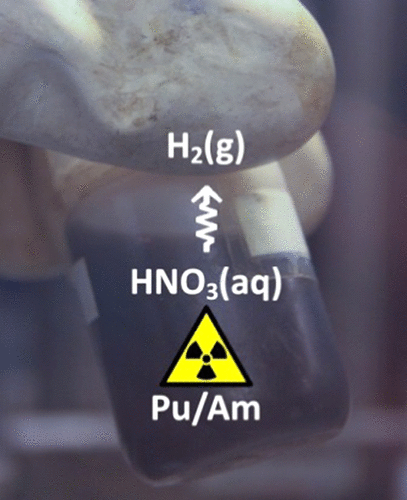当前位置:
X-MOL 学术
›
J. Phys. Chem. B
›
论文详情
Our official English website, www.x-mol.net, welcomes your
feedback! (Note: you will need to create a separate account there.)
Molecular Hydrogen Yields from the α-Self-Radiolysis of Nitric Acid Solutions Containing Plutonium or Americium
The Journal of Physical Chemistry B ( IF 2.8 ) Pub Date : 2018-02-22 00:00:00 , DOI: 10.1021/acs.jpcb.7b12267 Colin R. Gregson 1 , Gregory P. Horne 2, 3, 4 , Robin M. Orr 1 , Simon M. Pimblott 3, 4 , Howard E. Sims 5 , Robin J. Taylor 1 , Kevin J. Webb 1
The Journal of Physical Chemistry B ( IF 2.8 ) Pub Date : 2018-02-22 00:00:00 , DOI: 10.1021/acs.jpcb.7b12267 Colin R. Gregson 1 , Gregory P. Horne 2, 3, 4 , Robin M. Orr 1 , Simon M. Pimblott 3, 4 , Howard E. Sims 5 , Robin J. Taylor 1 , Kevin J. Webb 1
Affiliation

|
The yield of molecular hydrogen, as a function of nitric acid concentration, from the α-radiolysis of aerated nitric acid and its mixtures with sulfuric acid containing plutonium or americium has been investigated. Comparison of experimental measurements with predictions of a Monte Carlo radiation track chemistry model shows that, in addition to scavenging of the hydrated electron, its precursor, and the hydrogen atom, the quenching of excited state water is important in controlling the yield of molecular hydrogen. In addition, increases in solution acidity cause a significant change in the track reactions, which can be explained as resulting from scavenging of eaq– by Haq+ to form H•. Although plutonium has been shown to be an effective scavenger of precursors of molecular hydrogen below 0.1 mol dm–3 nitrate, previously reported effects of plutonium on G(H2)α between 1 and 10 mol dm–3 nitric acid were not reproduced. Modeling results suggest that plutonium is unlikely to effectively compete with nitrate ions in scavenging the precursors of molecular hydrogen at higher nitric acid concentrations, and this was confirmed by comparing molecular hydrogen yields from plutonium solutions with those from americium solutions. Finally, comparison between radionuclide, ion accelerator experiments, and model predictions leads to the conclusion that the high dose rate of accelerator studies does not significantly affect the measured molecular hydrogen yield. These reactions provide insight into the important processes for liquors common in the reprocessing of spent nuclear fuel and the storage of highly radioactive liquid waste prior to vitrification.
中文翻译:

含P或A的硝酸的α-自辐射解氢的分子产氢量
研究了充气硝酸及其与含p或a的硫酸的混合物进行α-射线分解后,氢分子产率随硝酸浓度的变化而变化的情况。实验测量结果与蒙特卡洛辐射轨道化学模型预测值的比较表明,除了清除水合电子,其前体和氢原子外,激发态水的猝灭在控制分子氢的产率方面也很重要。此外,溶液酸度的增加会导致轨道反应发生重大变化,这可以解释为由e aq –被H aq +清除形成H •的结果。。尽管p已被证明是清除低于0.1 mol dm –3硝酸盐的分子氢前体的有效清除剂,但先前报道的of对1至10 mol dm –3的G(H 2)α的影响硝酸未复制。模拟结果表明,in在较高的硝酸浓度下清除分子氢的前体时,p不太可能与硝酸根离子有效竞争,这一点已通过比较p溶液和a溶液的分子氢产率得到了证实。最后,放射性核素,离子加速剂实验和模型预测之间的比较得出结论,即加速剂研究的高剂量率不会显着影响所测得的分子氢产率。这些反应提供了对乏核燃料的后处理和玻璃化之前高放射性液体废物的存储中常见的酒类重要过程的见解。
更新日期:2018-02-22
中文翻译:

含P或A的硝酸的α-自辐射解氢的分子产氢量
研究了充气硝酸及其与含p或a的硫酸的混合物进行α-射线分解后,氢分子产率随硝酸浓度的变化而变化的情况。实验测量结果与蒙特卡洛辐射轨道化学模型预测值的比较表明,除了清除水合电子,其前体和氢原子外,激发态水的猝灭在控制分子氢的产率方面也很重要。此外,溶液酸度的增加会导致轨道反应发生重大变化,这可以解释为由e aq –被H aq +清除形成H •的结果。。尽管p已被证明是清除低于0.1 mol dm –3硝酸盐的分子氢前体的有效清除剂,但先前报道的of对1至10 mol dm –3的G(H 2)α的影响硝酸未复制。模拟结果表明,in在较高的硝酸浓度下清除分子氢的前体时,p不太可能与硝酸根离子有效竞争,这一点已通过比较p溶液和a溶液的分子氢产率得到了证实。最后,放射性核素,离子加速剂实验和模型预测之间的比较得出结论,即加速剂研究的高剂量率不会显着影响所测得的分子氢产率。这些反应提供了对乏核燃料的后处理和玻璃化之前高放射性液体废物的存储中常见的酒类重要过程的见解。











































 京公网安备 11010802027423号
京公网安备 11010802027423号